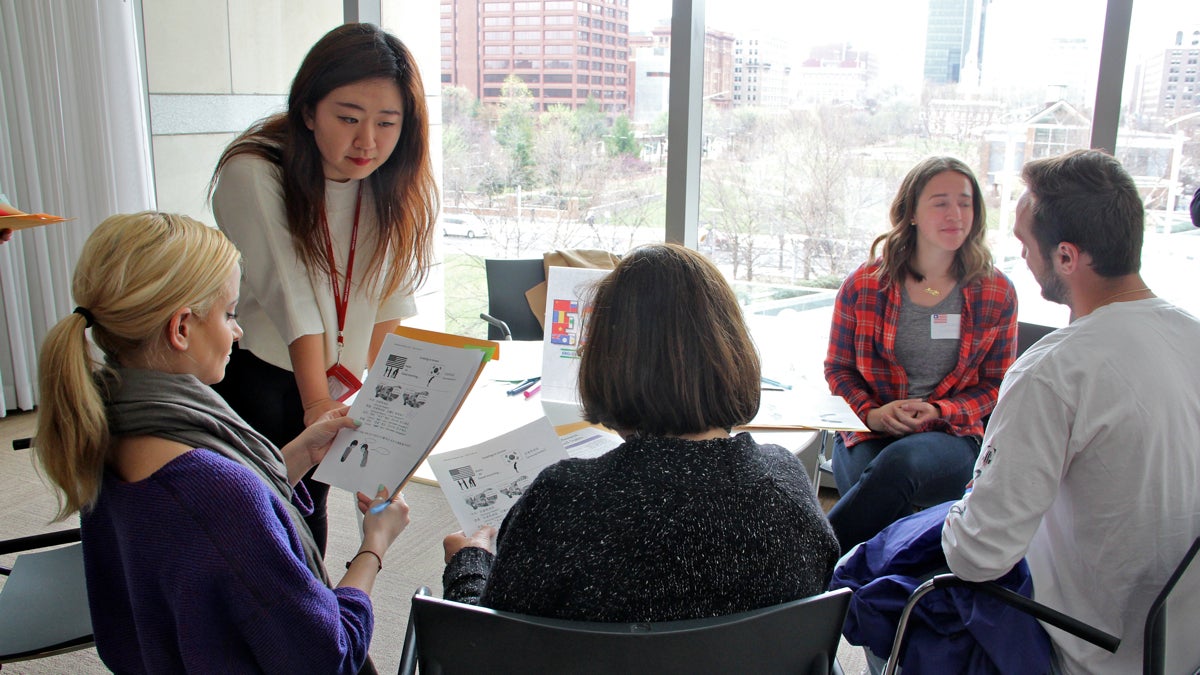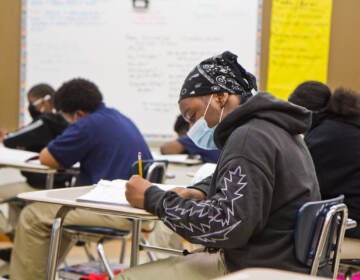English learners forum focuses on inclusivity, high-stakes tests

Min Soo Yoo gives her refugee students a feel for an immigrant's English as a second language class by teaching them Korean. (Emma Lee/WHYY)
The conversation began with a flurry of numbers.
About a 10th of students in the School District of Philadelphia are English language learners or ELLs. Combined, those ELL students speak more than 100 languages and attend nearly every district school. At 59 Philly schools, more than 10 languages are represented in the student body.
Those statistics, all accumulated by the nonprofit group Research for Action, laid the foundation for a forum hosted Wednesday night by WHYY and the Philadelphia Education Research Consortium. The topic was English language learners, and the message was clear: these students are legion, and they need more support.
The topic has extra resonance right now with the recent passage of a new student funding formula in Pennsylvania that attaches extra money to English language learners. (For a full breakdown of how the new formula works, click here.)
The panel discussion featured city, state, and district officials — all weighing in on the delicate topic of how to best educate these often-vulnerable students. Multiple strategies emerged, not all of them in perfect concert.
Some, for instance, urged school leaders to focus on inclusivity and community-building before pivoting to academic material.
“We just know students can’t perform their best when they’re feeling marginalized, insecure or put down in different ways,” said Ellen Somekawa, executive director of Folk Arts-Cultural Treasures Charter School in Chinatown. “And that stuff is just reduced when you invest in building community.”
Somekawa lamented the pressure on schools to “perform right now” on standardized tests, saying it distracted schools from building the supports immigrant students and English learners need.
Otis Hackney, chief education officer for Mayor Jim Kenney, also focused on building community. Before joining the administration, Hackney was principal at South Philadelphia High School. He earned wide acclaim for his leadership following revelations of violence against Asian students at Southern. The key in that case, Hackney said, was building “safe spaces” where students and administrators of different backgrounds could come together over shared interests such as breakdancing and pingpong.
“A student and I don’t have to speak the same language to realize, OK, Principal Hackney cares,” he said.
A new academic approach
Others, however, focused on academic rigor and the pedagogical strategies required to bring English language learners along.
Allison Still, deputy chief of multilingual curriculum and programs for Philadelphia district, said it has changed its approach in recent years. Rather than segregate English language instruction from other content areas such as math and science, the district wants English language learners exposed to “grade-level content” even if they’re just beginning to learn the language.
“Even at the very beginning levels of proficiency, [they] need to have access to the grade-level standards, even though it is challenging and it is difficult,” said Still. “But we have to get them started.”
That shift, however, requires a concurrent shift in how teachers are trained, argued Kinyata Smalls, director of bilingual studies and ESL for the Mastery Charter network. More general education teachers, she said, need training so they can provide “sheltered English” lessons within core curriculum classes.
“That would provide an immediate relief for our students,” said Smalls.
Linda Long, bilingual education adviser for the Pennsylvania Department of Education, said the state is moving in that direction and that new teachers are better prepared to think about the challenges English learners face than older generations of teachers.
Though the forum was billed as a discussion on English language learners, conversation predictably veered to divisive education issues such as school funding and standardized testing.
In Philadelphia last school year, just 8 percent of English language learners scored proficient on the statewide math assessment and only 9 percent score proficient in English. Both marks were well below the district averages of 18 percent and 34 percent respectively.
Hackney argued that recent revisions to state tests have further disadvantaged English language learners because of their increased focus on literacy. Even state math exams, for instance, require more language skills than in the past, he said.
“I would like to see some more work around the accountability of how we assess what a student knows or what they know how to do,” he said.
Calling for a change in perspective
Councilwoman Helen Gym, who helped found FACTS and is a longtime education advocate, called for a shift in how schools view English learners. If test scores and academics are the most important barometer of progress, she argued, those students are likely to be viewed as a liability.
“The typical way we look at English language learners and young children … is you must reach English proficiency,” she said. “You are kind of assessed by your level of English language proficiency as opposed to your value as being bilingual or multilingual.”
On that final point there was broad consensus. Many panelists urged school leaders to embrace the native language skills and cultural capital many immigrant students bring with them.
“ELL is an asset,” said Smalls. “And that’s the approach that we take. We work with students to leverage what they bring from their home country.”
WHYY is your source for fact-based, in-depth journalism and information. As a nonprofit organization, we rely on financial support from readers like you. Please give today.





